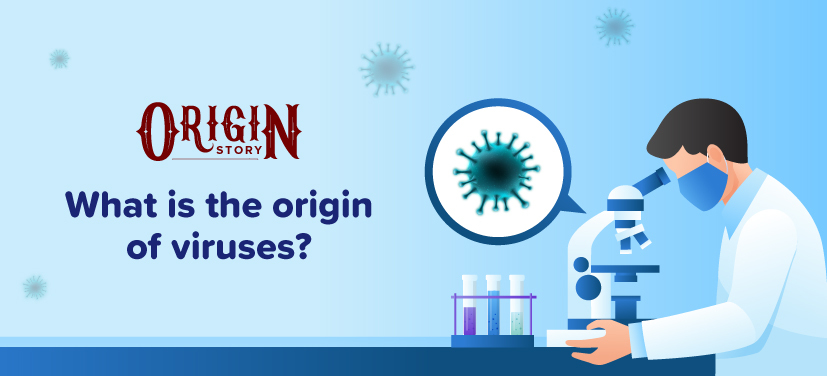
Viruses are microscopic parasites that live all around us on our planet. You may be shocked to know that there are more viruses on Earth than there are stars in the universe!
Viruses, unlike other earthly life forms, are considered to be neither dead nor living. These microorganisms have one purpose in life—to infect other living beings, be it bacteria, animals or plants.
But where did these infectious agents come from? Well, the history of viruses represents a fascinating, although murky topic for scientists.
No one really knows the answer, although science does suggest three possible hypotheses.
The progressive hypothesis, as the name suggests, states that viruses progressed or arose from small, simple genetic elements.
This theory argues that viruses are just special pieces of genetic information. These genetic elements somehow gained the power to move in and out of living cells on their own.
What’s most intriguing is that this hypothesis suggests viruses could have come from our own genes. There are special genes we have in our genome called transposons.
Transposons are also called ‘jumping genes,’ which is why they’re considered so special. These genes have the ability to jump from one location to another in the genome.
What’s a genome? Well, in simple words, a genome is an organism’s complete set of genetic instructions. Each genome contains all of the information needed to build that organism and allow it to grow and develop.

Transposons are also considered to be quite selfish. They “want” themselves to be duplicated and given more energy and attention. Like siblings competing for a parent’s affection, these genes “want” to be favoured. However, this isn’t feasible, because for life to thrive, all genes are important.
The ideology behind this theory is that viruses are actually jumping genes that threw a tantrum for not getting enough attention and ran away from home. That’s why the progressive hypothesis is also known as the “escape hypothesis”.
They gained the ability to leave their cells, formed a partnership with some proteins and together became able to infect other cells.
After infection, their DNA/RNA is forced into the host’s genome and duplicated and processed. They make new copies of themselves and then continue infecting other cells.
RNA viruses like the human immunodeficiency virus (HIV) work like these transposons.
This theory is the opposite of the progressive one, as the name suggests. This theory doesn’t argue that viruses progressed and adapted to think for themselves. Rather, it states that they are reduced parasitic forms.
There are some really large viruses, such as the smallpox virus or the Mimivirus (the world’s largest virus). Even though Mimivirus is still 50x smaller than the diameter of a hair strand, compared to other viruses, it’s a monster!
Such “massive” viruses led scientists to theorize that viruses may have come from very complex ancestral organisms. These complex ancestral organisms were believed to be working together within a symbiotic relationship or symbiosis.

Symbiosis is a close ecological relationship between the individuals of two (or more) different species. Sometimes a symbiotic relationship benefits both species, sometimes one species benefits at the other’s expense.
So, basically what happened is that with time, one organism may have become over-reliant on the other, thereby losing its essential genes. It was an evolutionary decision to get rid of these excess genes. There was no need to waste time and energy to maintain genes for the replication tools, as the partner did most of the work.
Basically, a perfectly happy symbiotic relationship turned into a toxic parasitic one and… voila! We now have viruses!
In summary, viruses were actually dependent cells that evolved into parasitic viruses. However, instead of evolution taking them a step forward, it went a step backwards!
This theory takes an entirely different approach. The above two hypotheses are only possible if cells existed before viruses. Yet, just like the timeless chicken and egg debate, we’re not actually sure which came first.
What if viruses came first? Evidence has come to show that viruses were actually the first replicating organisms in the world.
Many scientists conclude that since viruses are so much simpler than a cell, they must have evolved first.
 Scientists postulate that viruses existed in a pre-cellular world as self-replicating units. Over time, these units became more organized and complex, eventually resulting in the formation of cells. Viruses then may have existed before bacteria, archaea, or any other life form.
Scientists postulate that viruses existed in a pre-cellular world as self-replicating units. Over time, these units became more organized and complex, eventually resulting in the formation of cells. Viruses then may have existed before bacteria, archaea, or any other life form.
However, some scientists dismiss this hypothesis because of one key feature. According to the classical definition of viruses, they need a host’s cell to replicate. So, how could viruses have survived before the existence of cellular life?
Where viruses came from is not a simple question to answer. One can argue quite convincingly that certain viruses, such as the retroviruses of HIV, arose through a progressive process. Mobile genetic elements gained the ability to travel between cells, becoming infectious agents.
One can also argue that large DNA viruses arose through a regressive process whereby once-independent entities lost key genes over time and adopted a parasitic replication strategy.

Finally, the idea that viruses gave rise to life as we know it presents very intriguing possibilities. Perhaps today’s viruses arose multiple times, via multiple mechanisms. Perhaps all viruses arose via a mechanism yet to be uncovered.
In the end, we don’t know exactly which hypothesis is correct. Each one can be argued for, but all have their own shortcomings. For all we know, the answer could be entirely different!
Enjoyed reading this? Check out more such awesome content on The Learning Tree blog:
Raza has been writing since 2008, be it fiction, poetry, or articles on science, politics, and history. He believes that words can change the world, and he uses them to inspire and empower people through his writing. When he is not working, he is watching nature documentaries or playing with his cats.